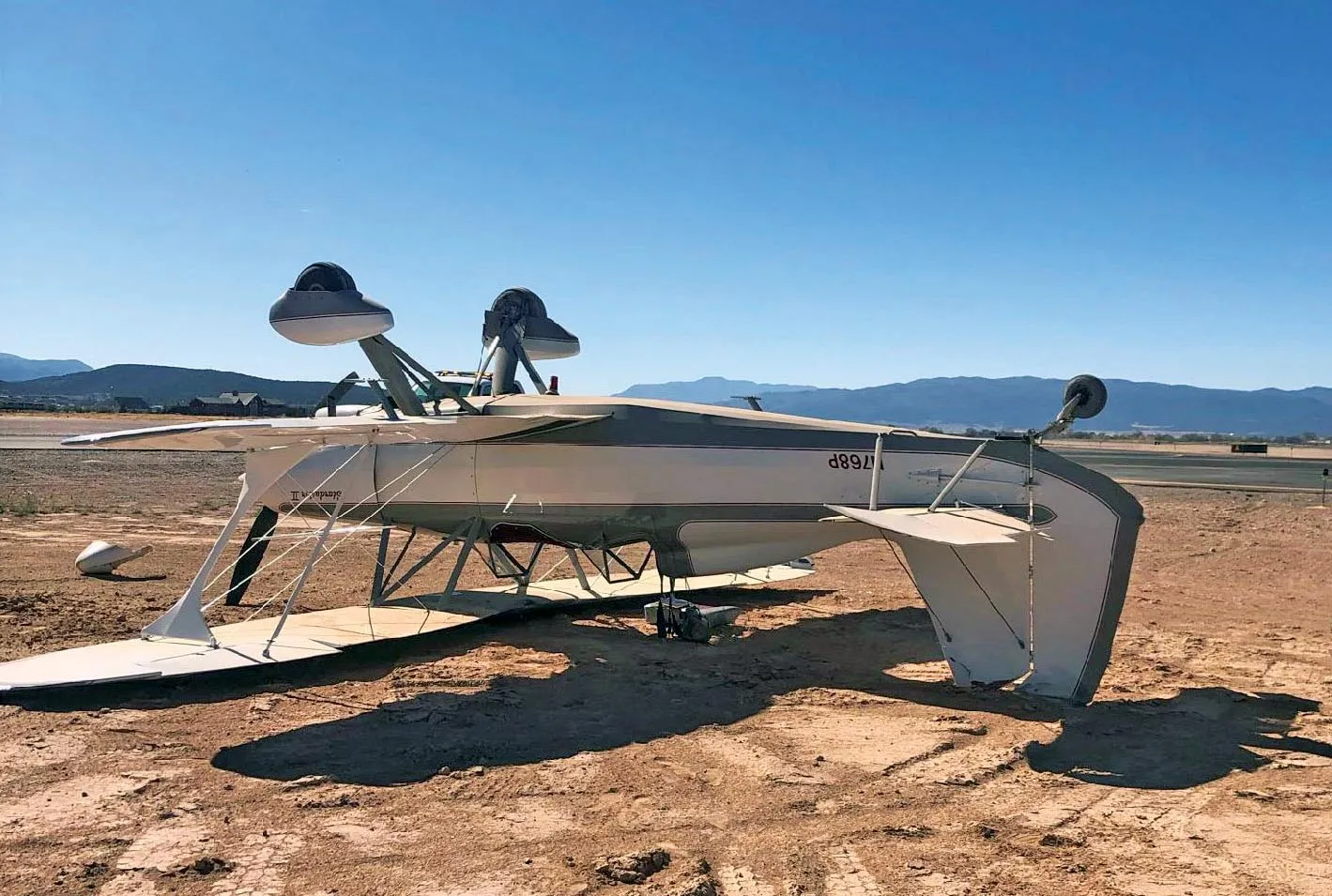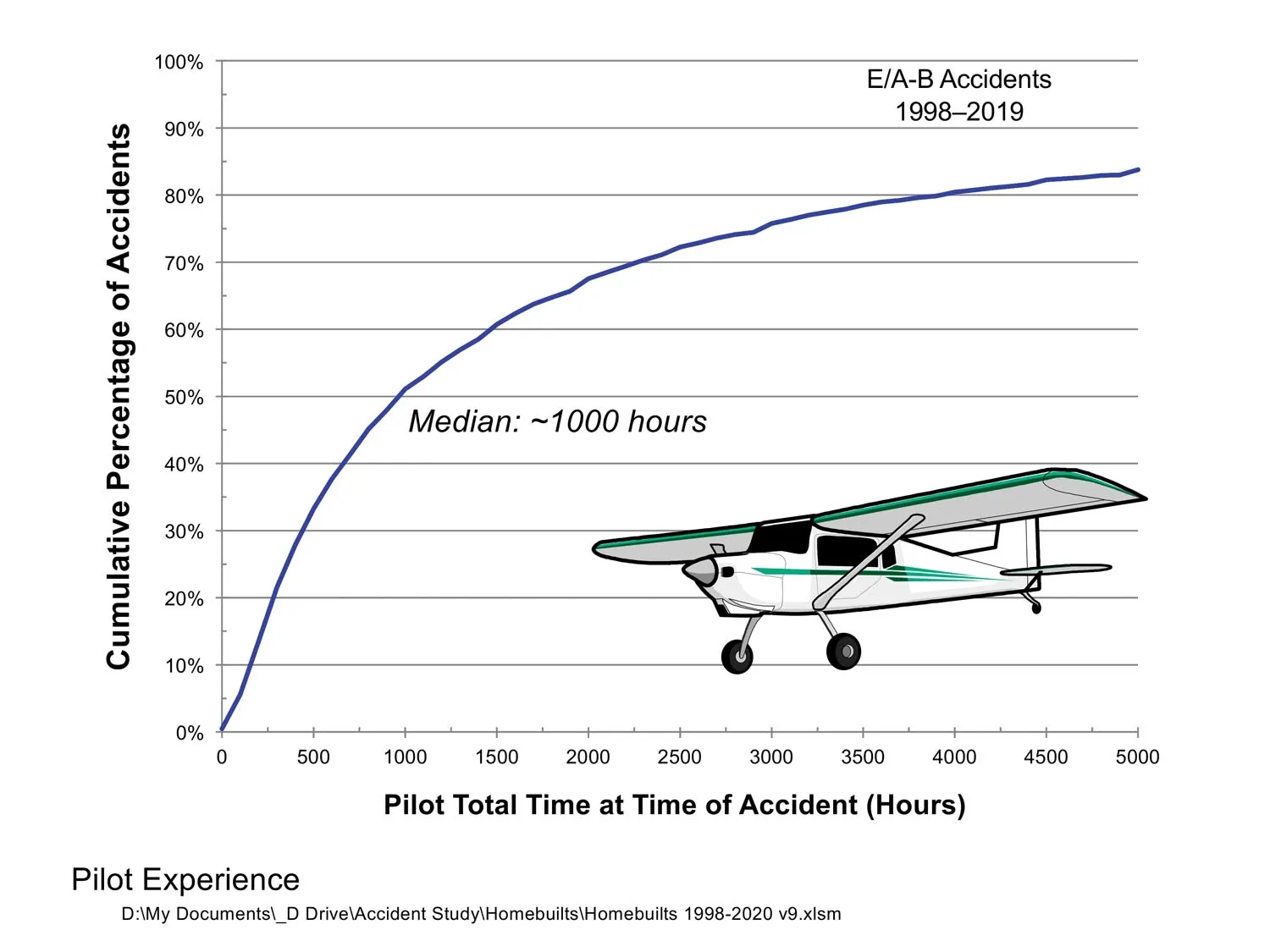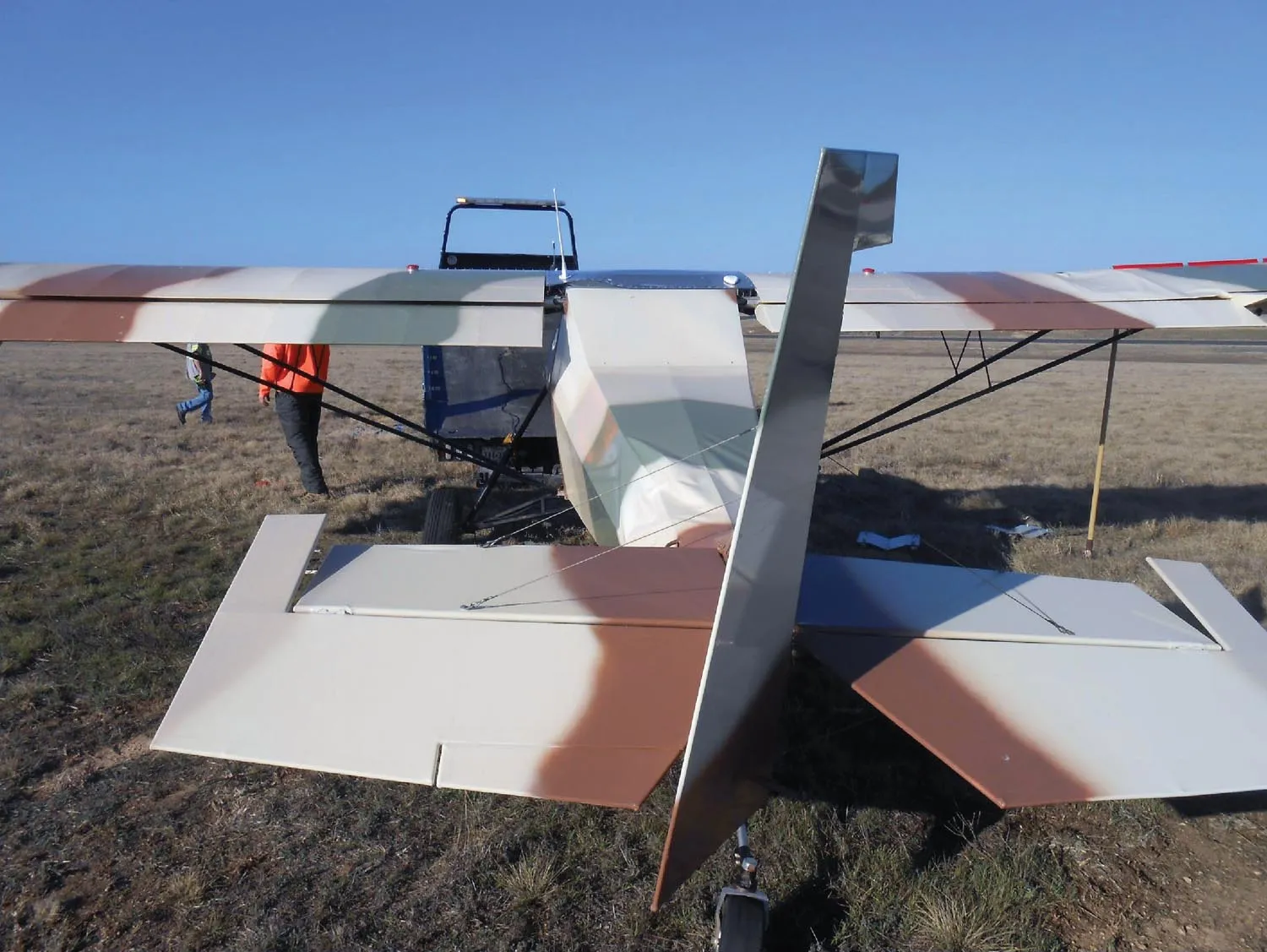
Considerable insights can be gained by examining aircraft accident statistics. But sometimes—well, the results aren’t earth-shattering, but can be interesting nonetheless.
Take the issue of pilot experience. We would certainly expect more-experienced pilots to make fewer mistakes. But what’s the actual difference?
It’s not something that’s only relevant to homebuilts. But my Experimental/Amateur-Built aircraft accident database gives us the opportunity to easily compare the accident causes for pilots at various levels of experience.
One little surprise does pop up…
Data
About 4000 accidents in my 22-year database (1998–2019) include the pilot’s total time. Pilots involved in homebuilt accidents have a median total flight time of about 1000 hours. The most experienced pilot had 42,000 hours. On the other end of the spectrum, 10 accidents featured pilot total time of zero hours. Most were ultralight-type vehicles, although the aircraft had N-numbers.

We don’t have a reliable source of statistics regarding the distribution of flying experience across the entire homebuilt fleet. So we’ll use the accident database and compare the causes of accidents. We’ll set up three sets, nearly equal in size, to compare. The sets will include all homebuilt accidents where the pilot’s total time was within the given range.
One hundred and forty-eight accidents occurred to pilots with 20,000 or more hours. We’ll call this the “ATP” set, though not all had airline transport pilot ratings (and not all ATPs are included).
A good comparison would be newly minted private pilots, so the second comparison set covers pilots who had 40 to 100 hours at the time of their accident. With 158 total accidents, it provides a close match in size to our ATP group. We’ll refer to these as the “Private” group, although, again, not all have private certificates.
We need something in the middle, so why not look at pilots around our 1000-hour median? There are 144 cases in the 1000- to 1150-hour range; we’ll call these the “Mid-Time” set.

Comparing The Accident Causes
The primary factor to be concerned with is pilot miscontrol. This category covers errors in the physical control of the aircraft. It doesn’t include judgment issues such as running out of fuel.
Results are probably pretty much as expected: About 51% of the accidents in the Private set are due to miscontrol, versus 37% for the Mid-Time set and 30% for the ATPs.
I’ll admit the ATP results came out higher than I expected. Part of the explanation came out when the miscontrol accidents were looked at in more detail, as seen in Figure 1. As one might predict, the number of stall- or wind-related accidents decreased with pilot experience.

What was a surprise was the result under “Landing Directional.” This category refers to the pilot losing directional control during landings. Note that Figure 1 does not show the percentage of accidents—it’s the actual number of cases, comparing near-equal-size sets. And it shows that the most experienced pilots suffer more accidents due to losing control on landing: only five of the 158 accidents in the Private set, versus 19 out of the 148 in the ATP set. Three times the number of accidents! Over 40% of the ATP set’s pilot miscontrol accidents are loss of directional control on landing.
What’s more, we’re seeing similar results in the Mid-Time set: 15 out of 144 accidents.
Why?
The Answer, In One Word
Taildraggers. Fourteen of the 19 loss of directional control on landing cases for the ATP set had conventional gear.
Almost 60% of the total accidents in the ATP set involved taildragger aircraft, versus less than 40% for the Private set. The Mid-Time set was also higher.
You’d think that the ATP taildragger accidents would tend to occur during initial checkout. Of the 14 cases, though, only two have a time-in-type indicative of the first or second flight in the airplane. Four of the pilots had over 100 hours in type.

Lessons
It’s said that the Piper J-3 is the safest airplane in the world because it can just barely kill you.
But it should be obvious that 30 years of flying a 767 from Tedium to Apathy and back doesn’t really prepare you for flying said J-3 Cub. Nor a Kitfox, nor a Starduster, nor an RV without the “A” in the model name.
There’s no question that conventional-gear aircraft appeal to older professional pilots. The ATP accident set has about one-third more taildraggers than the Private set, irrespective of whether the accident was due to loss of control of the airplane during landing.
Overall, more-experienced pilots suffer fewer accidents due to stick-and-rudder mistakes. They maintain proper airspeeds, handle winds better and avoid porpoising and botching the flare.
But airplanes don’t care if their pilots are 40-hour fledglings or 30,000-hour sky gods. The high-time folks may find flying more natural and automatic. But the airplane just doesn’t care.
Give the aircraft your best, whether the card in your wallet says student or ATP.

This article originally appeared KITPLANES. For more great content like this, subscribe to KITPLANES!



































In Figure 1, where would you place a pilot with 500 hours experience?
I looked at my data, and found exactly 150 accidents for pilots in the 500 hour to 560 hour range. There were 65 miscontrol accidents (e.g. stick and rudder mistakes), which would have nestled nicely between the Private and Mid-Time sets (81 and 53, respectively).
One of the interesting things about the 500-560 hour set is the higher percentage of taildraggers… over half, which is the highest of any of the sets I examined. It’s reflected in the “Landing Directional” cases; just as many as the ATP set.
Gusty winds are not the only contributor to ground-loops. An Aft -CG will help it swap-ends also as longitudinal control degrades.
I’ve been personally involved in only One Ground-Loop… in the early ‘80s…I owned an Aeronca Chief which had brakes (if you could call them that… mechanical heel-brakes) only on the left crew-position.
I was a 7K-hour ATP and I was checking-out my corporate co-pilot, also a 3K-hour ATP, in the Chief. It was a gusty day with a right-crosswind. The airplane had an 8-gal aux tank behind the baggage compt and so we had an Aft CG….
On his first attempt at a crosswind landing …the right crosswind tried to weathervane the airplane as we touched-down…and Mike tried to apply left-brake to prevent that weathervaning…JUST as the crosswind abruptly stopped.
The airplane swung out-of-control to the left, leaving the runway and sliding backwards into the grass…ending up facing the direction from which we’d approached. The engine was clicking-over slowly picking up tall grass-stems and tossing them into the air…
Fortunately, the wingtips did not contact the ground and there was no damage….but Mike un-clipped his seat-belt, stepped out of the plane remarking…”Yeah…You’re gonna teach ME how to land this thing!”
He walked away leaving me in the idling airplane’s right seat …with no brakes….it beginning a gentle roll back towards the runway… (wide-open-eyes emoticon here)
LOL I learned never to train someone in a taildragger without also having brakes on my side…and remembering to caution them that I cannot “UN-brake” their braking-action…. When I say “My Airplane!”…. they MUST release ALL controls. (wink)
In the old days almost all trainers were taildraggers. Over the years tricycles took over. That spoil the game of flying. When you land a tricycle, the aircraft can almost do the job of keeping strait it self. Not the taildragger. Yea, “everybody” knows that and yet we see discrepancy between the two in big numbers. The numbers don’t lie. “Landing Directional” in a taildragger is a full time job. Meaning, the pilot cannot relax one split second after the tail-wheel touches the ground, especially when in high speed. Full attention and quick to respond to the demands of keeping strait is not an easy job. Put cross winds and gusts into the equation and you have a full blown challenge job to keep directional control. It’s interesting to see that the numbers are lower for the low time taildragger Pilots and higher for the ATPs. It’s easy to understand. I usually hear people saying: “Oh, he is pilot of 747 for 20 years!”, “Oh, he is instrument certified” what I say when I hear that is: So what? they get mad at me LOL
If those ratings were assurance of less taildragger lost of directional control when landing, the numbers would show. Apparently it’s not the case. So, yes, keep your eye when landing a taildragger all the way to the end. Only relax when the aircraft has cleared the RWY which in this case the speed is supposedly to be slow enough to not cause any harm of directional control. But, hey! for those that taxi like speed racers only relax when the the mags are dead! : )
Tedium to apathy? I’m sure you are an experienced 767 SKY GOD who has landed on a contaminated RWY with low ceilings, RVR and a crosswind after being up all night and concerned about 250 passengers that may have been injured because of unforcased turbulence, or 1000 KM from the nearest airport while a passenger is having a heart attack.
There are all types of pilots, cropdusters, carrier pilots, fighterpilots, airline pilots, airshow pilots on and on. Each pilot is low time when in a different kind of aircraft. I find your article inaccurate. If you have a heart attack I hope you don’t choose a brain surgeon, both well qualified.
“Tedium to apathy and back” is a tribute to a line in a very famous book that became a very famous movie. I’ve used in several articles over the last several decades, and no one has caught on yet.
Let’s just say that Marc Cook should check to see if his palm tree is missing…..:-)
Mr. Roberts. Wonderful movie.
That was a long way of saying you utterly missed the point.
Well put, Ron. One of the more dangerous parts of aircraft sales is doing demonstration flights with high time ATP’s. The salesman or demonstration pilot, if not forewarned, can easily get lulled into a false since of security only to find themselves out of energy ten feet plus over the runway in a plane without ten feet plus of landing gear.
Similarly, I had a flight with a conventional gear pilot who was trying his best not to put the tail down with the mains in our new tricycle gear demo plane, and needed help not to damage the plane.
As far as instructing in a tailwheel airplane, I have seen high time pilots do some AMAZING things upon landing!!
I learned to fly in a Cub at Stormville, NY. Trained on O-1 Bird Dogs. Flew a Pitts S-1 for 300 hours. And I’m still making hairy landings in a J-3 Cub I’ve owned for 25 years. One word- pavement.
If bears remembering that when someone can rightfully be considered a “highly qualified pilot”, the word qualified must also be qualified. I remember vividly the day I turned the controls of my old C-182 over to a friend, a Navy carrier pilot fresh from his last stint as Top Gun instructor and who likely had few peers in the Tomcats they flew then. His landing was spot on, as was the final approach speed I had suggested, but the wide-eyed look on his face when the pavement interrupted his carrier-honed constant descent and the Cessna’s springy gear launched us back into the sky nose high at near-stall speed was unforgettable.
No one builds an experimental that copies a C172: they want something wilder or faster or more manuverable or slicker or more fun. So yea, they get what they get.
These comments are All (taken as a group) Excellent.
A bit of vitriolic expostulation ain’t bad, Dad. A lot can be.
We live in an era of fake charity yet hope does spring eternal.